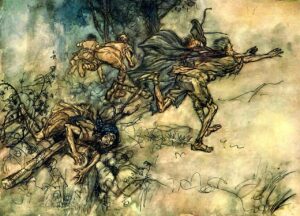What is the inciting incident? Many writers have asked themselves that question, and for a good reason. The inciting incident definition, sometimes called the catalyst, is integral to any story. The event sets the plot in motion, and it is critical to ensure that it is effective.
This blog post will discuss the inciting incident, its purpose, and how to use it effectively in your writing. In addition, we’ll provide many examples from books and films to help you understand how it works.
Why is the inciting incident essential for storytelling?
A strong inciting incident is an event that sets the plot point in motion and starts the chain of events leading to the climax of a story. Therefore, it is essential to ensure that it is adequate to hook your readers and keep them invested in your story.
There are many different inciting events, but they all have one thing in common: they must be attractive. If your inciting moment isn’t engaging enough, you risk losing your reader’s attention.
Key elements that make an inciting incident effective:
1. It should be surprising but not too confusing.
2. It should introduce the central conflict of the story.
3. It should be related to the main character in some way.
Examples of effective inciting incidents:
A good inciting incident should be unexpected but not too improbable. It should also be closely related to the main conflict of the story.
For example, in Agatha Christie’s And Then There Were None, ten strangers are invited to a remote island, only to discover that they’re being murdered one by one. The invitation itself is the inciting incident, leading to the horrific events that follow.
– In the movie Jaws, the inciting incident is when a woman is attacked by a shark while swimming. This event raises the stakes for the main character, Chief Brody, who must now find and stop the shark before it can attack anyone else.
– In the movie Psycho, the inciting incident is when Marion Crane steals money from her employer and decides to go on the run. This sets up the movie’s suspenseful plot, culminating in Marion being murdered by Norman Bates.
How to use the inciting incident to create a powerful story
The inciting incident is the event that sets the story in motion and propels the protagonist towards their goal. It’s an essential component of a well-crafted story and can make or break a thriller.
– The inciting incident should happen as early as possible in the story arc.
– It should be active rather than passive. In other words, it should be something that happens to the character rather than something the character observes.
– It should raise the stakes for the character.
– It should introduce at least one new element into the story.
Examples of new elements:
-It could introduce a sense of unease or menace. This can help create a sense of anticipation and foreboding, setting the stage for what’s to come.
-It could introduce a new (and dangerous) character to the story or reveal hidden secrets about the characters or the plot that have been previously unknown.
-It could also escalate the action and suspense in the story, leading to more dramatic and intense scenes.
In short, there are endless possibilities for what an inciting incident can do to spice up a thriller plot!
Examples of the inciting incident in action

Everyone has their specific favorite example of the inciting incident in action.
Here are a few examples that tend to thrill audiences:
-The protagonist receives a mysterious letter or phone call, setting them on a quest for answers.
-The sudden and unexpected murder of a character, signaling that nobody is safe.
-A citywide blackout or power outage creates an eerie and suspenseful atmosphere.
-A natural disaster strikes without warning and throws the protagonist into a life-or-death situation.
-The theft of classified documents from a government officials’ office.
-A car accident that reveals a hidden body.
-The discovery of a dead body in a remote location.
-A group of people being stranded in a remote location with no way to escape.
-A bomb going off in a crowded area.
No matter what form it takes, when the inciting incident occurs, it is designed to send the story hurtling forward while simultaneously leaving the audience on the edge of their seats, waiting to see what happens next.
How to determine if your story has an effective inciting incident
The inciting incident is the event that sets your story in motion, and that should be clear from the beginning. It doesn’t have to be something big or dramatic; it can be something small and seemingly insignificant. But it should be something that matters to the protagonist and gets them invested in resolving the conflict.
If you’re having trouble coming up with an effective inciting incident for your story, try thinking about what event would create the most conflict for your protagonist. What’s the worst thing that could happen to them? How can you ensure that this event will have a lasting impact on the rest of the story?
Remember, the inciting incident is where the story starts – the beginning of your protagonist’s journey – there’s a lot of adventure waiting for them (and your audience) down the road.
Here are some questions to ask yourself:
– Does the inciting incident make the reader want to know what happens next?
– Does the inciting incident introduce the central conflict of the story?
– Does the inciting incident set up the stakes for the story?
– Is the inciting incident intriguing or exciting enough to keep readers reading your story?
If you can answer “yes” to all of these questions, you likely have a great inciting incident!
Examples of inciting incidents in popular books and films:

You can find examples of inciting incidents in many popular books and movies. Here are a few:
– In the novel, The Catcher in the Rye, the inciting incident is when Holden Caulfield is kicked out of his boarding school and decides to run away from home. This sets up the novel’s coming-of-age story, as Holden learns about life and responsibility during his adventures in New York City.
– In the movie Die Hard, the inciting incident is when terrorists take John McClane’s wife Holly hostage. John then has to save her and the other hostages.
– In the novel The Hunger Games, the inciting incident is when Katniss Everdeen is chosen as a tribute for the Hunger Games. This sets up the norm for the fight between the Capitol and the districts and Katniss’ journey to survive the Games.
– In the movie The Incredibles, the inciting incident is when Mr. Incredible saves a man from suicide, which leads to him being sued and eventually forced into hiding. This sets up the film’s plot, about Mr. Incredible having to defeat a villain while also keeping his family safe.
– In the play Romeo and Juliet, the inciting incident is when Romeo Montague falls in love with Juliet Capulet, who is from a rival family. This sets up the conflict between the two families and eventually leads to Romeo being banished from Verona.
Tips for implementing the inciting incident into your writing
There are ways to implement your inciting incident depending on what you are trying to achieve with your story.
If you want to create conflict:
Have your protagonist face an obstacle that they must overcome. This can be something as simple as a character flaw or an external problem like a superstorm heading towards New York.
If you want to generate sympathy:
Have your protagonist suffer some loss or tragedy. This will make your audience feel empathy for what your character is going through.
Remember, the inciting incident is the event that sets the story in motion, and without it, your story will likely stall. So make sure to choose when deciding what will happen in your story’s inciting incident!
Final thoughts on this critical storytelling tool

It won’t be easy for you to get your story off the ground without an exciting inciting incident. So, with careful planning and execution, you need to use this tool to create an engaging and compelling story that will keep your readers hooked from beginning to end.
Start brainstorming for that inciting incident to make your story a big success, and you’ll be on your way!
Conclusion
The inciting incident is one of the most essential story elements, and it can be used to create a more engaging experience for your readers. By understanding the inciting incident and how to use it effectively, you can improve your storytelling skills and keep your readers hooked until the end.
If you’re working on your first novel and are looking for more help with your writing, please check out our other articles at https://ullahakanson.com/blogs/
Good luck and happy writing!
Ulla

